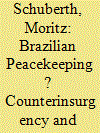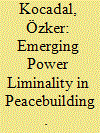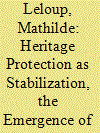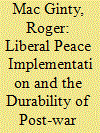|
|
|
Sort Order |
|
|
|
Items / Page
|
|
|
|
|
|
|
| Srl | Item |
| 1 |
ID:
166785


|
|
|
|
|
| Summary/Abstract |
Brazil’s role in UN peacekeeping operations has been subject to increasing attention from academics and policy makers alike. While some authors praise Brazil’s engagement in the United Nations Stabilization Mission in Haiti (MINUSTAH) as a case of innovative South-South cooperation, others accuse Brazil of using Haiti as a ‘testing ground’ for repressive anti-gang tactics that have subsequently been introduced at home. This article challenges these two dominant views on Brazil’s role in Haiti. Based on a period of six months of fieldwork in Port-au-Prince and interviews with key Brazilian actors, the article draws a parallel between MINUSTAH’s military raids in gang-ruled neighbourhoods coupled with police reform in Haiti, on one hand, and the Pacifying Police Units (Unidade de Polícia Pacificadora) plus the accompanying UPP Social in Rio de Janeiro, on the other hand. It is argued that Brazil’s peacekeeping strategy, at home and abroad, is a mix of coercive and cooperative measures reminiscent of counterinsurgency (COIN) tactics already employed during the French colonial war in Algeria. Moreover, it is shown that policing techniques borrowed from the US are employed to ease the tension between carrots and sticks, notably so in the urban environment in which Brazilian peacekeeping is taking place.
|
|
|
|
|
|
|
|
|
|
|
|
|
|
|
|
| 2 |
ID:
166783


|
|
|
|
|
| Summary/Abstract |
International peacebuilding is no longer dominated by Western actors and their liberal peace framework, neither there is a full-fledged alternative formulated by emerging peacebuilding actors. In this paper, I first establish the relationship between the liminality of emerging powers and their mimicry of the liberal peace. Secondly, I distinguish three forms of mimicry in peacebuilding that stem from emerging power liminality: a discursive mimicry, a complete mimicry and a substantive mimicry. In the case of the discursive mimicry, there is a liberal peacebuilding discourse which is rarely substantiated with policies. The complete mimicry is when both the liberal discourse and the policies are mimicked, and the substantive mimicry is a genuine adaptation of the liberal peacebuilding by the emerging power. The case of Turkish peacebuilding is analysed to illustrate the tripartite distinction. I demonstrate that Turkey mimics solely the discourse of the democratic peace thesis, while there is a complete mimicry of the Western model in security sector reform. However, the Turkish civil society peacebuilding and Turkey’s approach to economic development substantively mimic their liberal peace counterparts. This article contributes to the critical literature on liberal peacebuilding by identifying the different forms of emerging actors’ mimicry of the liberal peace.
|
|
|
|
|
|
|
|
|
|
|
|
|
|
|
|
| 3 |
ID:
166782


|
|
|
|
|
| Summary/Abstract |
The integration of new tasks like those of cultural and natural heritage management into the mandates of UN peace operations is usually presented as a burden, ‘a star on the top of the Christmas tree’ at a time of scarce human and budgetary resources for contemporary UN peace operations. Through a comparison of MINUSMA in Mali and MONUSCO in DRC, this article aims to demonstrate how, on the contrary, heritage management can bring consistency to the broader ‘stabilization’ mandate mainstreamed in UN peace operations. By creating new links between the seemingly dichotomous activities it encompasses, namely ‘support’ and ‘securization’ activities, this new type of mandated task can increase complementarity between civilian and military components of UN peace operations with regard to local population. As part of their stabilization mandates, both MINUSMA and MONUSCO were charged to protect heritage. Ultimately, the most decisive factor as to why heritage management created a virtuous circle in Mali and a vicious circle in DRC, seems to be the failure or the success on the part of peace operations to include local communities in the heritage management process, a task which is so far better performed by the civilian than by the military component.
|
|
|
|
|
|
|
|
|
|
|
|
|
|
|
|
| 4 |
ID:
166784


|
|
|
|
|
| Summary/Abstract |
This article examines the correlation between the implementation of liberal peace provisions in peace accords and the duration of peace by drawing on data from the Peace Accords Matrix that comprises 34 comprehensive peace agreements signed in the post-Cold War period. Our key findings confirm that the duration of peace is improved when the liberal aspects of peace included in peace accords are implemented. In addition, the article examines peace duration in relation to UN peacekeeper deployment and mechanisms for peace accord verification – in an attempt to establish factors that enhance the duration of peace. Peacekeeping is found to have a positive impact, while verification mechanisms do not. The findings highlight the need to unpack and scrutinize more thoroughly the complex roles of liberal peacemaking.
|
|
|
|
|
|
|
|
|
|
|
|
|
|
|
|
| 5 |
ID:
166781


|
|
|
|
|
| Summary/Abstract |
Coherence is a core objective in most multinational interventions and seems of particular relevance to UN peacekeeping missions with their increasing complexity and multidimensionality. Yet, coherence has rarely been studied empirically. We borrow the concept of ‘fit’ from organizational theory and use it to develop a conceptual framework to study coherence in peacekeeping operations. Fit is the degree of match between what is required by the mandate, on the one hand, and an institutional set-up and the implemented practices, on the other. We identify three relevant dimensions of fit to study coherence: strategic and organizational, cultural and human and operational fit. Our empirical material focuses on the UN mission in Mali (MINUSMA) and in particular on the interplay between the intelligence components and the rest of the mission. We draw upon a large empirical dataset containing over 120 semi-structured interviews, field observations and participation in pre-deployment exercises and evaluation sessions. Our empirical analysis suggests that low level of fit across several dimensions leads to inertial and widespread frictions in the practice of peacekeeping and could potentially undermine peacekeeping effectiveness. Building on existing scholarship on micro-level approaches to peacekeeping, we hope to further the debate on organizational dynamics within peace operations.
|
|
|
|
|
|
|
|
|
|
|
|
|
|
|
|
|
|
|
|
|